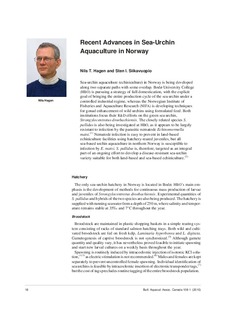| dc.contributor.author | Hagen, Nils T. | |
| dc.contributor.author | Siikavuopio, Sten Ivar | |
| dc.date.accessioned | 2016-09-02T10:15:25Z | |
| dc.date.accessioned | 2016-09-13T11:42:36Z | |
| dc.date.available | 2016-09-02T10:15:25Z | |
| dc.date.available | 2016-09-13T11:42:36Z | |
| dc.date.issued | 2010 | |
| dc.identifier.citation | Bulletin of the Aquaculture Association of Canada 2010, 108(1):18-22 | |
| dc.identifier.issn | 0840-5417 | |
| dc.identifier.uri | http://hdl.handle.net/11250/2406716 | |
| dc.description | - | |
| dc.description.abstract | Sea-urchin aquaculture (echiniculture) in Norway is being developed along two sep a rate paths with some overlap. Bodø University College (HBO) is pursuing a strategy of full domestication, with the explicit goal of bringing the en tire production cycle of the sea urchin under a controlled industrial regime, whereas the Norwegian Institute of Fisheries and Aquaculture Research (NIFA) is developing techniques for gonad enhancement of wild urchins using for mulated feed. Both institutions focus their R&D efforts on the green sea urchin, Strongylocentrotus droebachiensis. The closely related species S. pallidus is also being investigated at HBO, as it appears to be largely resistant to infection by the parasitic nematode Echinomermella matsi.(1) Nematode infection is easy to prevent in land-based echiniculture facilities using hatchery-reared juveniles, but all sea-based urchin aquaculture in northern Norway is susceptible to infection by E. matsi. S. pallidus is, therefore, targeted as an integral part of an ongoing effort to develop a disease-resistant sea-urchin variety suitable for both land-based and sea-based echiniculture.(2) | |
| dc.description.abstract | Sea-urchin aquaculture (echiniculture) in Norway is being developed along two sep a rate paths with some overlap. Bodø University College (HBO) is pursuing a strategy of full domestication, with the explicit goal of bringing the en tire production cycle of the sea urchin under a controlled industrial regime, whereas the Norwegian Institute of Fisheries and Aquaculture Research (NIFA) is developing techniques for gonad enhancement of wild urchins using for mulated feed. Both institutions focus their R&D efforts on the green sea urchin, Strongylocentrotus droebachiensis. The closely related species S. pallidus is also being investigated at HBO, as it appears to be largely resistant to infection by the parasitic nematode Echinomermella matsi.(1) Nematode infection is easy to prevent in land-based echiniculture facilities using hatchery-reared juveniles, but all sea-based urchin aquaculture in northern Norway is susceptible to infection by E. matsi. S. pallidus is, therefore, targeted as an integral part of an ongoing effort to develop a disease-resistant sea-urchin variety suitable for both land-based and sea-based echiniculture.(2) | |
| dc.language.iso | eng | |
| dc.title | Recent Advances in Sea-Urchin Aquaculture in Norway | |
| dc.title.alternative | Recent Advances in Sea-Urchin Aquaculture in Norway | |
| dc.type | Journal article | |
| dc.date.updated | 2016-09-02T10:15:25Z | |
| dc.identifier.cristin | 680703 | |
| dc.subject.keyword | Akvakultur / Aquaculture | |
